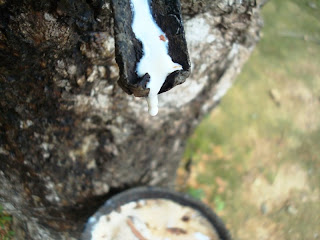Our guide, having introduced herself as Oom (honestly), delivered us and the minibus full of French and German tourists to a rubber plantation on mainland
We were ushered into the cave, passing through an enormous stone archway, while the monkeys swarmed around us. The interior of the cavern was enormous, cavernous even, and contained various towering statues, all painted stone and all at least three hundred years old. I sighed with relief as we passed beneath the shadows of the peeling, cracked and grimacing sculptures – finally, some real Thai history! I frequently shuffled up to Oom to ask questions, learning that the idols guard the cremated ashes of Buddhist monks, and that the presence of the monkeys is holy to them. The air was heavy with the lingering presence of the past, and the weight of the silence and solidarity pressed upon our ears. I couldn’t resist buying a tiny, carved sandstone Buddha which Nick eyed suspiciously before snorting with disbelief when I told him the price.
My own little Buddha
Pushed for time, I rushed up to an elderly lady and bought some nuts to feed to the monkeys. I turned to make sure Nick was in the vicinity, camera at the ready; but before I knew it the cackling old woman had crammed my pockets full of the things. I gulped when a fat adult
I battle the monkey
Discarding the last of the nuts into the now-screeching throng, we once again entered the bus and let ourselves be shepherded to the coast.
Aww, baby monkey!!
The boat appeared to have a monstrous engine strapped to the back, as though somebody had sneaked into a farm and ripped out the internal workings of a tractor. Now enclosed in lifejackets, Nick and I took our seats near the very back of the boat, and worryingly close to the beast machine. I turned to Nick as a man attempted to tug the engine into life. “Do you think it will be too loud to tal-” I began before an eardrum-bursting roar tore through the air, instantly drowning me out. Nick looked relieved for some reason.
On the boat - with the monster engine in the background
It was time for some lunch. My stomach sighed happily before promptly imploding as I realised where we had docked, all of us very wet and very deaf: Pannyi, a floating fisherman’s village. Yes, a fascinating place. An entire community, complete with people, animals and its own economy, permanently lashed to wooden boards and forever floating, never touching dry land. Yes, I was incredibly lucky to be there. But it was a fishermen’s village. Fishermen fish. For fish. So lunch was, logically, to consist entirely of seafood, which I despise eating. I muttered prayers under my breath as we were seated at a beautifully prepared table and sobbed when prawns, rice and fish and shrimp were laid our before us. Mercifully, a measly piece of chicken was proffered in my direction, which I seized ravenously and swallowed whole. Nick contentedly helped himself to the extensive fish dishes.
Pannyi Village
We were unleashed upon the village and given the freedom to roam wherever we wished, providing we didn’t wander into the sea as this may have infringed upon certain insurance procedures. The village itself was very much like a smaller, quieter, and less odious Patong. Although in Patong, the residents tend to venture from their city unlike the inhabitants of this buoyant society, who spend their entire lives at sea and do not once set foot on dry land.
Once again boarding our superpowered vessel, we sped to the entirely stunning rock structure of Ko Tapu, marketed and known colloquially as
Ko Tapu (James Bond Island)
Naturally, it provided ample photo opportunities as Nick and I scrambled up and down rock stairways, searching for the best spot. “That should be your Facebook profile image!” soon became the ultimate compliment to the quality of a picture. Before long, we bundled ourselves into the boat and set off for the final leg of our journey.
Irrefutable proof that Nick and I have been to Thailand!
On arrival at an odd sort of stationary floating boat, we were told to line up, keep on our lifejackets and sit in pairs on a succeeding line of dinghy-canoe-things, each controlled by a Thai fellow wielding a double-edged paddle. The last one swung by: Nick hopped in and I teetered on the edge before heavily flopping down, causing the entire vessel to rock. Our man paddled us skilfully across the water, and it became apparent that we were to be given a tour of the bay and its countless tunnels. I shan’t bore you with an entire account of the trip, but we swept under extremely low tunnelled ridges forcing us to lie flat and for me to gradually disappear slowly into my lifejacket like a tortoise, and into mini flooded valleys, enclosed by towering stone walls and lidded with thick tree canopies.
One of the many ridges...
I prepare to lie horizontally
A flooded valley
Through a cavern
Eventually, exhausted and soggy, we found ourselves back on the boat, speeding towards the port where we had begun this voyage. In all, the events of the day had been satisfyingly authentic, providing tradition, zoology, history, and geology. And not a single monkey riding a tricycle in sight.



















Good! Monkeys on Tricycles are not good. Glad you got to see what wild monkeys used to humans are like - greedy! Lovin the blogs, just catching up after my trip away!
ReplyDelete